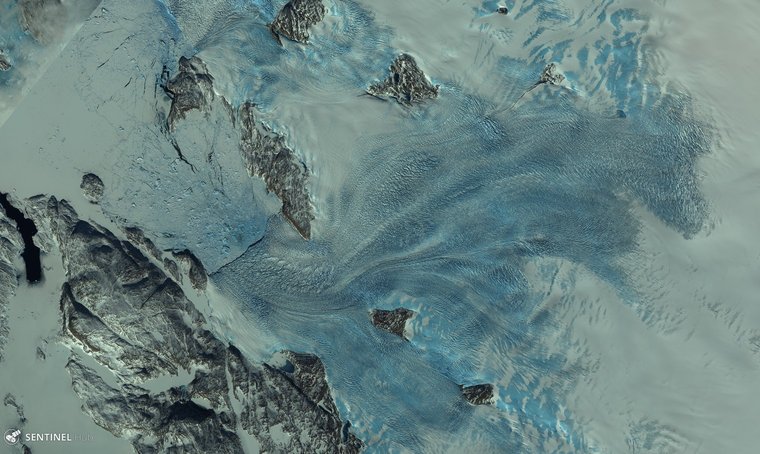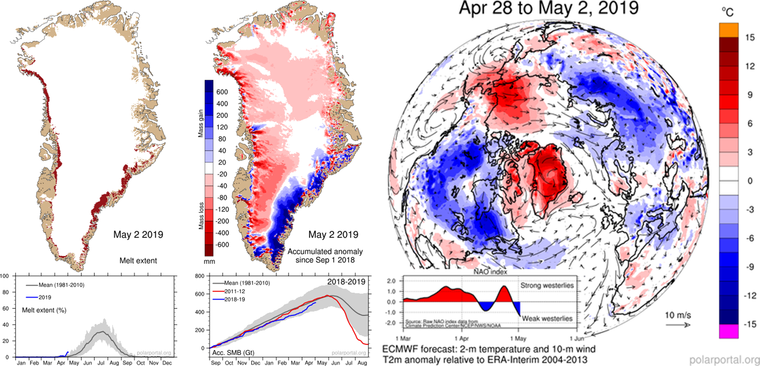Greenland melt season officially starts almost a month early
May 3rd, 2019
Today DMI scientists announced the start of the Greenland melt season, the second earliest in a record that stretches back to 1980. “The start of the melt season occurs on the first of three consecutive days where more than 5% of the ice sheet has melt at the surface.” said scientist Peter Langen. “We use a pretty strict definition as we want to make sure it is a consistent start to melting and not just a blip due to unseasonal weather”. This year’s start of 30th April is second only to 2016, when a very unusual weather pattern caused a very early start to the melt season in mid-April.
“On average, the melt season starts around the 26th May, so we are almost a full month earlier this year” he continued.
Number three on the list is 2nd May 2010 when a similar weather pattern also caused early melt onset closely followed by 2017 on the 7th May, the top four have all occurred within the last ten years.
However, weather patterns in the North Atlantic are important for controlling how early melt gets going, 2015 for example was the 3rd latest start to melting in the record after late snowfalls in spring reduced melting and joint 5th place on the list is 2006 and 1990.
The early melt onset (left), red shows areas where melting is occurring. Centre: the dry winter over most of Greenland compared to normal is shown in red, the blue area shows places where more snow than usual has fallen since 1st September 2018. Warmer than usual air over Greenland, Baffin Bay and the central Arctic is visible in red (right), the North Atlantic Oscillation is shown in the graph underneath.
“This winter a persistently positive north Atlantic Oscillation – the weather pattern that also largely controls how cold and wet northern European winters are has led to a generally dry and cold winter in Greenland” said climate scientist Martin Stendel. “IN many ways Europe and Greenland have opposite weather patterns, a mild wet winter in europe often means a relatively cold and dry winter in Greenland”.
The persistent dry winter followed by a mild April has consequences for Greenland glaciers.
“Through most of the winter, the majority of the ice sheet has been unusually dry, which sets it up for enhanced melting - if the right weather conditions occur – in the summer this year” said scientist Ruth Mottram. “A period of warm sunny weather will soon melt this winter’s thin snow cover exposing the darker glacier ice underneath. If this happens we would then expect much faster melting as the dark glacier ice absorbs more energy from the sun than snow. But it all depends on the weather”.
There is an exception though, south east Greenland, where most of the snow in Greenland falls has had an exceptionally wet spring with a lot of snow and rain associated with storms tracking through the north Atlantic. “Actually, there have been several records broken in Greenland for extreme weather in April. Tasiilaq in south east Greenland had its wettest April on record. Aputiteeq, Tasiilaq, Ikermiuarsuk and Summit had their warmest April on record and the Summit station on the top of the ice sheet measured the warmest temperature ever in April, -1,2C on April 30, which is incredibly warm for more than 3000m in altitude. The old record was -6.5C, though this record only goes back about 20 years.” said DMI climatologist John Cappelen.
The warm air mass moving over the Greenland ice sheet has been key to the extensive melting observed this week but substantial melting started already in early April and on the 15th April, field scientists from the PROMICE project observed unusual amounts of melting at quite high elevations in southern Greenland.
https://twitter.com/climate_ice/status/1117809484737536000
Most of this early melting will first refreeze in the underlying snowpack, as shown in the beautiful blue colours visible from satellite (see below) in areas where melting has already got under way. Only later in the season, when the snowpack has disappeared will the melt start running off to the ocean in large quantities, the period known as the ablation season to ice sheet scientists. Overall, the date of onset of the melt season in Greenland does not appear to be strongly connected with the amount of ice that melts over a full season and much will depend on weather over the summer season as to whether or not this will be another record-breaking ice loss season like 2012 or a more muted affair like 2016.
 |
Polar Portal is a collaboration between DMI, GEUS and DTU with funding from Dancea (Danish Cooperation for Environment in the Arctic) under the Danish Ministry for Energy, Utilities and Climate.
Polar Portal is also on Twitter: @PolarPortal and Facebook: https://www.facebook.com/PolarPortal/.






